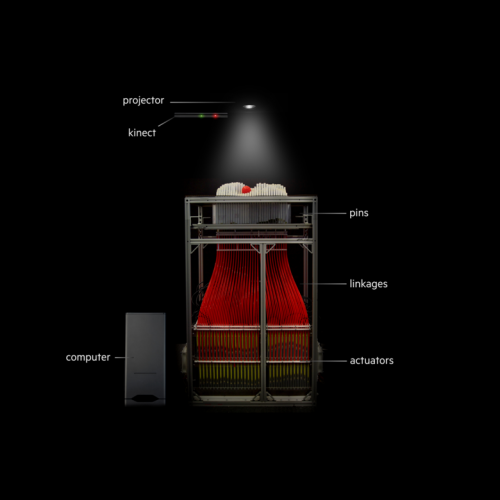(Phys.org) —The Tangible Media Group at MIT Media Lab have been working on a shape-shifting surface called inFORM where, as their video indicates, users interact with digital matter in interesting ways that go far beyond boxed-in interactions with a traditional computer. Outside MIT, observers have described their system not only as a shape display but as a shape-shifting surface; The team at MIT that is behind inFORM explain it as a "Dynamic Shape Display that can render 3D content physically, so users can interact with digital information in a tangible way. inFORM can also interact with the physical world around it, for example moving objects on the table's surface. Remote participants in a video conference can be displayed physically, allowing for a strong sense of presence and the ability to interact physically at a distance."
Their paper, "inFORM: Dynamic Physical Affordances and Constraints through Shape and Object Actuation," by Sean Follmer, Daniel Leithinger, Alex Olwal, Akimitsu Hogge and Hiroshi Ishii of the MIT Media Lab, explains the system in detail. They wrote that the system is a shape display that enables "dynamic affordances, constraints and actuation of passive objects. Shape displays allow for more general purpose shape change than many other actuated or shapechanging interfaces, and thus are ideal research platforms."
Shape displays still remain limited in scale and cost, they said, but "this work is an exploration of the interaction capabilities and is meant to inspire further research in this area. Our belief is that shape-changing interfaces will become increasingly available in the future, and this work tries to push towards creating a vocabulary and design space for more general-purpose interaction for shape displays, including rendering of both content and UI elements."
A key comment that indicates the role of inFORM within their overall research efforts is what they say on their inFORM web page: "InFORM is a step toward our vision of Radical Atoms."
The Tangible Media Group explain how they view graphical user interfaces, tangible user interfaces, and Radical Atoms: "A graphical user interface only lets us see information and interact with it indirectly, as if we were looking through the surface of the water to interact with the forms below." A tangible user interface, meanwhile, is "like an iceberg: there is a portion of the digital that emerges beyond the surface of the water—into the physical realm—so that we may interact directly with it." Radical Atoms describes the group's "vision for the future of interaction, in which all digital information has physical manifestation so that we can interact directly with it—as if the iceberg had risen from the depths to reveal its sunken mass."
They are now exploring application areas for the inFORM shape display. How could it be used in real-life scenarios? The team sees one potential in geospatial data, such as maps, GIS, terrain models and architectural models. "Urban planners and architects can view 3-D designs physically and better understand, share and discuss their designs." They would also like to explore surgical simulations.
More information:
tangible.media.mit.edu/project/inform/
tangible.media.mit.edu/vision/
© 2013 Phys.org

























